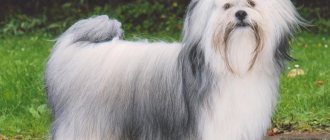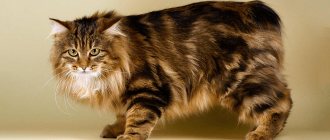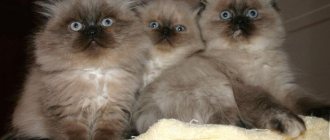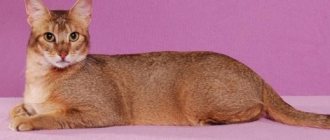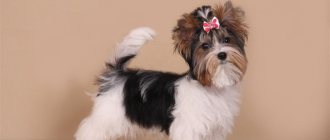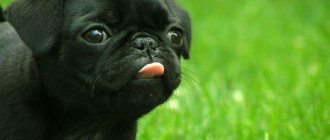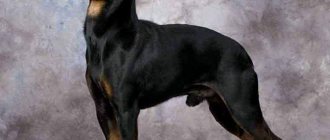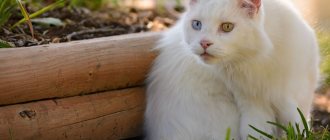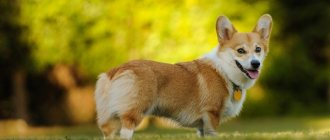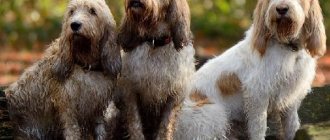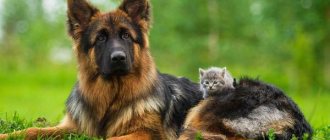History of the breed
The Tibetan Terrier is the oldest breed bred in Tibet.
The homeland of the Tibetan Terriers is Tibet, an isolated territory, which is why there is no reliable information about the ancestors of the pets. It is believed that the first representatives were used as shepherds, and then they found their calling in the monastery, as a watchman. According to ancient belief, representatives of this breed were a talisman against evil forces and were recognized as sacred animals.
At that time, the pets were called “Tsang Apso”, which translated meant “Shaggy Dog of the Tsang Province”. Puppies could not be bought by a stranger, especially a citizen of another state, but they were presented as a gift, as a sign of special favor.
This is how the first puppy came to the UK. In the 20s of the 20th century, it was presented to the English doctor A. Greig, who took up the issue of breeding individuals in her country. The breed was named “Lhasa Terrier” and only in 1937, when a standard was developed, was the official name “Tibetan Terrier” assigned to it.
Important! Tibetan Terriers are the progenitors of the Lhasa Apso, Shih Tzu and local spaniels.
Origin
The Tibetan Terrier is one of the oldest dog breeds. For some unknown reason, there are references to India as the homeland of these dogs. This is not true, if only because Tibet, the homeland of dogs, is geographically located in China. Misinformation about India may be due to the fact that this country has a government in exile, the Dalai Lama, the supreme ruler to whom all Tibetan monks obey. Terriers from Tibet are directly related to them. In ancient times, shaggy, unpretentious and hardy animals were kept in the mountains as shepherds and guards. They calmly endured the cold and wind, as well as the rarefied air of the highlands. This breed had no equal until the Tibetan mastiffs appeared. About terriers: these were larger than average dogs, but when smaller puppies were found in litters, they were taken to Buddhist monks: it was believed that such dogs were special.
Thus, all small individuals were separated from the general flocks, and in the monasteries no one sterilized them, they mated with each other. This kind of selection lasted quite a long time. As a result, the first Europeans who came to Tibetan monasteries became acquainted with small dogs with beautiful long hair. They gave the dogs their name - although they have nothing to do with terriers. Other names were Lhasa Terrier, Lhasa Apso, and long-haired Tibetan breed. It was impossible to sell this dog: Tibetan clergy gave them to dear guests. English travelers were among them. And the breeding of Tibetan terriers began in England, where the main lines were Lamlech and Lanville.
The difference from the Lamlech and Lanville (old English lines of this dog breed) of modern mixed types is that the dogs of these lines had only a white-gray color. Lanville lasted longer than Lamlech, but to update the genotype in the 80s, breeders decided to return to the old type. The main difficulty in breeding the Tibetan Terrier of the Lamleh line is its late maturation.
The Germans also bred dogs of this breed. There is even an old German type of Lhasa Terrier. Breeding work began on the eve of the Second World War. Hitler sent multiple expeditions in search of Shambhala, and local small dogs were also brought as gifts from Tibet. But during the war, almost the entire livestock died. It was possible to restore the breed only in the post-war period. This breed was officially recognized by the International Canine Association in 1934.
Photo and description of the breed
The purebred Tibetan Terrier is a strong dog with a well-developed, proportional physique. The body is toned, muscular with thick skin.
A male dog is distinguished from a female by a more developed physique and a thick coat, but it is the former that has special requirements.
Terriers require careful grooming, especially their coat.
Grooming a dog should only be done by a professional groomer in a salon.
A dog needs constant attention from its owner
The dog's walks must be active, otherwise he will be restless
The breed is highly trainable due to its excellent intelligence.
Diet of the Tibetan Terrier
It is preferable that the volume and composition of food correspond to the parameters of the dog. She should not be overfed and should not be fed the same food or food from her table for a long time.
The main products included in the animal’s diet are:
- poultry meat;
- fish fillet;
- buckwheat and rice porridge;
- vegetables;
- milk products.
Tibetan Terrier puppies should eat at least 6 small meals a day. The older the pet gets, the less often it eats, but the portions become larger.
The terrier should always have a separate bowl of clean water. It is possible to feed with dry food, but the transition to it should be smooth, about 7 days.
General information and breed standards
In accordance with the approved FCI standard, pets must meet the following parameters:
- The skull is of medium length, not flat, with a smoothly defined stop.
- Scissor bite.
- The eyes are widely spaced, not protruding, dark brown in color.
- Neck with developed muscles, acceptable length.
- The ears are shaped like the letter “V”.
- The tail is ring-shaped, and often has a kink at the end.
- The body is square-shaped, with developed muscle mass.
- The legs are strong, straight, the pasterns are slightly inclined.
- The coat consists of two layers.
- Wool - one-, two-, three-ton.
Important! A chocolate-colored coat is strictly prohibited.
The color of pets is varied, but the chocolate tone is a defect
What does a Tibetan Terrier look like?
This is a strong and hardy medium-sized dog with long and thick hair.
This description of the Tibetan Terrier breed may not seem plausible, but this is only because due to the voluminous coat, a truly muscular back is not visible. It has an average height of about 40-45 cm. The coat is long and abundant, can be either straight or wavy, but without curls.
A photo of a Tibetan terrier can be confused with a photo of a soft toy.
The standard colors of this breed are black, white, gold, cream or bi-color.
The developed neck smoothly transitions into the shoulders and allows the dog’s head to be held above the back line.
The terrier's head has the shape of a square, on which the parting of long hair is clearly visible, the muzzle is covered by bangs, which do not interfere with the dog's vision, and the hair on the lower jaw resembles a beard.
The only area where hair does not grow is on the nose, which is mostly black in this breed.
The terrier's muzzle is absolutely proportional: the distance from the nose to the eyes is equal to the distance from the eyes to the occipital protuberance. Their jaw is very well developed and their bite has a regular scissor shape.
Note!
Nicknames for dogs for boys - easy, rare and most beautiful names for dogs in alphabetical order
Nicknames for girls' dogs - a list of beautiful, funny, unusual nicknames for large and small dog breeds
Maltipoo dog - everything about the dog from A to Z. Photos, description of the breed, character, maintenance features, prices, reviews
Round dark eyes are set wide apart, which gives them expressiveness. The drooping ears, completely covered with hair, are located almost close to the head, so they are very difficult to see.
The strong body allows you to see the straight outlines of the top and a slightly convex, not long loin. The tail is not very long, covered with a sufficient amount of hair, and is moderately curved over the back.
The forelimbs have abundant hair, the shoulders are slightly sloping, the paws are large and round with fur between the toes and pads.
The hind limbs are distinguished by well-developed muscles and also have a thick layer of hair.
Features of character and behavior
These individuals are extremely dependent on human communication. They were originally bred as companion dogs, which is why affection for people is in their blood. The animals have a balanced temperament. However, they are terrible owners and are not ready to share the owner’s attention with anyone else.
Nature has endowed these dogs with intelligence. With quality training, they can easily learn the technique of following commands.
This variety is an active dog, which means that a potential owner should think about whether he can devote several hours a day to intensive walks before purchasing. The walking route should be varied, since the same routine will quickly get boring.
Important! The owner should pay increased attention to raising the dog, otherwise he risks getting an eccentric and capricious creature.
Advantages and disadvantages
Absolutely any breed has both pros and cons; all that remains is to carefully study them before letting a dog into your home.
Pros:
- These individuals have a calm character; they will not rush around the house, demolishing everything in their path.
- Boundless devotion to the owner and his household.
- High security qualities.
- Low level of aggression, but not if family members are threatened.
Minuses:
- The need for constant human presence.
- From puppyhood, you will need to teach your dog not to bark without a serious reason.
- Pronounced jealousy if the owner pays attention to another pet.
Without proper training, the dog will bark often, which can become a reason for a scandal with neighbors.
Color variations and appearance
The appearance of representatives of this breed requires a careful description.
The weight of males is 9-14 kg, height 35-40 cm. The weight of females reaches 7-13 kg, and height 32-40 cm.
The wool is two-layer. The undercoat is thick and dense, and is better developed in males than in females. The guard hair is long, thin and somewhat stiff. The disadvantage is the fluffy coat, and because it is silky, the dog may be disqualified from breeding.
Important! Curly hair is an ironclad reason for disqualifying a dog.
The breed standard assumes the following colors:
- plain uniform;
- two-ton;
- three-ton;
- Peebold - white, with spots of a different tone.
Attitude towards children and pets
The attitude towards children cannot be characterized unambiguously. On the one hand, they tolerate games favorably and allow the child to pull their fur, but everything changes when the owner begins to pay more attention to the child than to the dog.
Pets do not like to share their owner’s attention, so it is necessary to immediately clarify that he does not occupy a leading position in the house
Care and maintenance
The owner of the Tibetan Terrier should understand that caring for the animal will require not only a lot of time and effort, but also financial investments, especially when caring for the coat.
Combing/grooming
The dog's coat needs reliable protection, so in slushy and dirty weather, it is necessary to wear overalls that completely fit the body. Your pet should be brushed daily, and dirt from the fur can only be cleaned with a special shampoo. Haircut is carried out only by a professional.
Bathing
It is necessary to bathe the dog as soon as the fur becomes dirty, because it is its main asset. You should wash only the wool, avoiding contact with the skin, as they can cause allergies. After the procedure, the animal must be wrapped in a towel and dried.
Walk
Tibetan Terriers are naturally active and require vigorous, long walks. During the day, the animal is walked 2 times, and the duration of stay on the street should not be less than one and a half hours.
Ears
The ears are inspected daily and cleaned as contamination occurs using a cotton swab.
Claws
The claws are cut with scissors 1-2 times a month, but in the warm season, the pet can grind them off on the asphalt.
Teeth
Dental care is carried out weekly using a toothbrush and a special dog paste.
It is necessary to accustom the dog to the procedure from the very beginning of the dog’s stay in the house, then the adult will be calm about the procedure.
Eyes
Frequent discharge from the eyes is a particular problem for the breed, so they should be examined and cleaned regularly.
The eyes are a weak point, and therefore the hair around them should be cut only as a last resort, since it is a kind of protection
Briefly about the main thing
- The Tibetan Terrier is an ancient breed of dog that is not related to terriers;
- Belongs to the number of small and rare;
- The coat needs daily care and trimming every six months;
- They are unpretentious in feeding;
- There are no obvious genetic pathologies;
- A puppy costs from 25 to 50 thousand rubles.
Which of our readers has a Tibetan terrier? Let's talk about them: temperament, feeding and care. Share your experience in the comments, please.
Did you like the article? Share it with your friends on social media. networks. This will help them get useful information and support our project.
Training and education
The training process should begin from the first days of the animal’s stay in the house. Initially, he needs to be accustomed to his place, shown who is in charge in the house, and then just start training.
The dog will need to be taught basic commands, such as:
- "place";
- "ugh";
- "to me";
- "near".
Important! If difficulties arise at any stage, it is better not to experiment and contact a specialist.
Physical exercise
Individuals of this species require any physical activity. Walks should be energetic and should include running, playing with a ball, and even better, go to the dog park, where the pet can run around to its heart's content.
Is it possible to keep in an apartment?
Tibetan terriers are versatile in keeping, so they easily adapt to living both in a city apartment and in the area adjacent to the house.
Prices for Tibetan Terrier
This breed is very popular among buyers, so finding out how much a Tibetan terrier costs is not at all difficult on the Internet.
The price will depend on the pedigree of the puppy, and if you are not going to participate in exhibitions, then you can get a puppy cheaper.
On average, the price of a Tibetan terrier puppy ranges from 40 to 50 thousand rubles.
Life expectancy and major diseases
The most problematic area is the eyes, which are hidden behind thick fur. A special predilection has been identified for pathologies of the lens and retina. Teeth are also at risk, and the most common disease is tartar.
Other major diseases are:
- joint dysplasia;
- conjunctivitis;
- tendency to obesity.
The life expectancy of pets is up to 15 years.
With quality care, a dog can live a long life without disease.
Diseases
Tibetan Terriers have excellent health and are long-lived. Quite often they live up to 15-18 years, but this is only possible with proper care and timely consultation with a doctor for treatment.
The breed is predisposed to diseases:
- obesity. You will need intense physical activity and a balanced diet;
- diseases of the musculoskeletal system;
- eye diseases;
- heart rhythm disturbance;
- otitis.
Most of these diseases develop in Tibetan terriers with age. No obvious genetic pathologies were identified. Timely vaccination and preventive treatment against parasites are necessary.
Mating
To obtain offspring, it is better to contact a kennel club. Both the female and the male must have show grades that are sufficient for breeding.
The first mating can be carried out when the female has reached the age of 1.5 years, and the male has reached 1 year. But it is still better to postpone mating until the age of 2-2.5 years, because that is when the body reaches full maturity.
Important! You can introduce a couple on a walk, but for mating you should prefer the territory of the male.
The breed should be prepared in advance for mating by choosing a high-quality pair
Nutritional Features
As a rule, individuals of this breed do not suffer from problems associated with the digestive system, therefore, you can choose any brand as an industrial feed. If the owner has time to prepare food for the animal, then it is better to choose a natural diet.
The basis of a natural diet is meat and low-fat varieties of offal. Occasionally, you can give the animal boiled sea fish, after removing the bones from it. The diet is also based on porridge and vegetables.
It is strictly forbidden to feed boiled eggs, cottage cheese and any fermented milk products. Any sweet, fried, spicy or fatty foods are prohibited.
Health issues
Despite their strong muscles and good endurance, Tibetan terriers often get sick. This is due to vulnerable immunity. If an animal is attacked by a pathogenic virus, the body needs a lot of strength and energy to fight it.
For example, such a dog may get a cold. Typically, this occurs during prolonged exposure to frost in winter. The best prevention of colds in dogs is insulation. Pet stores sell overalls for animals to wear in cold temperatures.
Another common ailment among Tibetan terriers is cataracts. How can you tell if your dog has this disease? His eye lens will become cloudy. You will not be able to cure cataracts in your pet on your own, of course, unless you have the appropriate education. To reduce the risk of diseases in your dog, preventive measures should be taken:
- Give her quality food.
- Treat illnesses in a timely manner.
- Periodically treat her fur with anti-parasite medication.
- Rinse your eyes with tea leaves.
How to choose a puppy
When moving on to buying a puppy, it is recommended to pay attention to the following factors:
- Availability of pedigree and exhibition ratings of mother and father.
- You should also examine documents about their health status.
- Is the mating registered?
- Presence of metrics in the puppy.
- Health status. The animal should not look scared or lethargic, its fur and eyes should be clean.
Important! Attention must be paid to the nursery, and it is better to choose one that has a good reputation.
The puppy should not be afraid of humans, otherwise this indicates low security qualities
How to name
The nickname is given to the pet based on its pedigree, or the owners come up with it themselves. The options you can choose from are:
For boy:
- Rick;
- Ron;
- Thomas;
- Yucca;
- Ricci.
For girl:
- Ani;
- Lizzie;
- Daisy;
- Jesse;
- Wanda.
